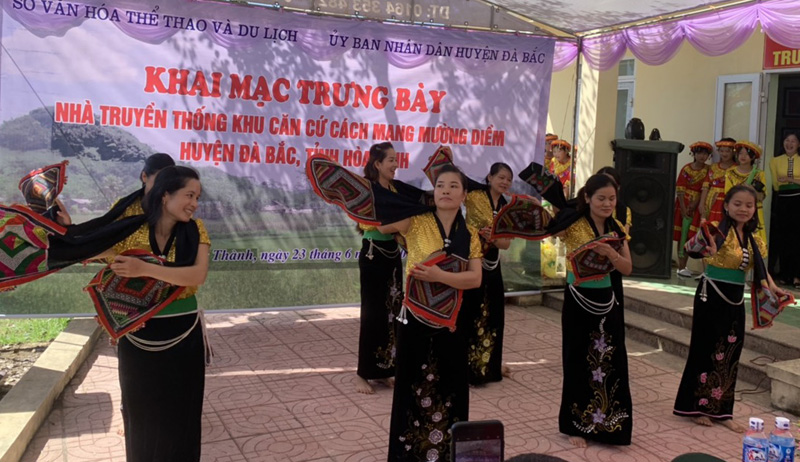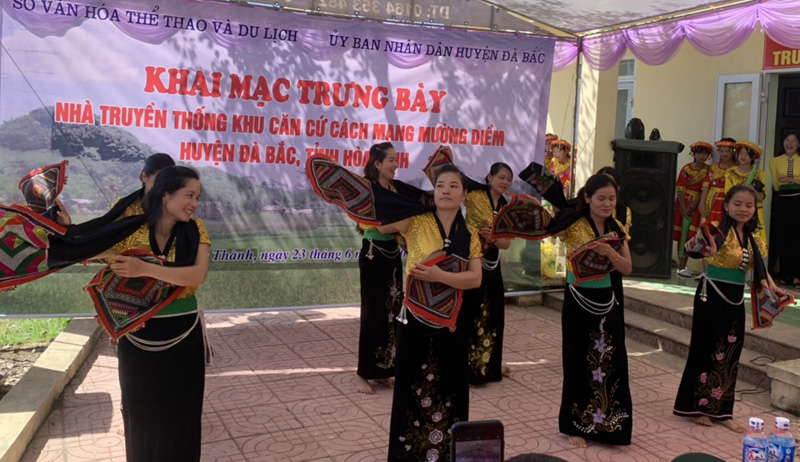
(HBO) – Da Bac district has worked to expand its movement to get all the people united in enhancing cultural life over recent years.
 A dance performance staged
during the launching ceremony of an exhibition house at Muong Diem
Revolutionary Base in Da Bac.
A dance performance staged
during the launching ceremony of an exhibition house at Muong Diem
Revolutionary Base in Da Bac.
All the criteria of the movement on building
culture families, villages
and residential areas have been popularised among the hamlets to encourage the locals to create improvements in their own families and neighbourhoods.
The district has
also promoted democracy regulations at the grassroots level and built civilised lifestyle and culture families which aim to
positively transform cultural standards.
Cultural and
sport events have been regularly organised in order to preserve and promote
traditional cultural values.
Last year, more
than 11,350 households in the district were recognised as culture families,
accounting for 79,2 percent of the total; while 110 residential zones and 74
organisations and agencies received the status, or 90.2
percent and 97.4 percent, respectively.
Up to 29.5
percent of the people in Da
Bac do physical exercises regularly and there are 35 sport clubs in
the district.
The movement has
achieved many encouraging results, contributing to promoting traditional
cultural values and community solidarity, beefing up economic growth and
building a civilised
lifestyle and a healthy
cultural environment./.
With an increasingly vibrant and widespread emulation movement aimed at building cultured residential areas and cultured families, Yen Thuy District has been making steady progress toward improving both the material and spiritual well-being of its people, while fostering a civilized, prosperous, beautiful, and progressive community.
Once lacking recreational spaces and community facilities, Residential Group 2 in Quynh Lam Ward (Hoa Binh City) has recently received attention for the construction of a new, spacious, and fully equipped cultural house. The project followed the model of state support combined with public contributions in both labor and funding.
The "All people unite to build cultural life" movement, which has been effectively integrated with Kim Boi district’s socio-economic development goals, is fostering a lively spirit of emulation across local residential areas, hamlets, villages, public agencies, and enterprises. In addition, through the initiative, traditional cultural values are being preserved and promoted, while community solidarity and mutual support in poverty reduction and economic development are being strengthened.
A working delegation of the Hoa Binh provincial People’s Committee led by its Permanent Vice Chairman Nguyen Van Toan on June 11 inspected the progress of a project to build the Mo Muong Cultural Heritage Conservation Space linked to tourism services in Hop Phong commune, Cao Phong district.
Born and growing in the heroic land of Muong Dong, Dinh Thi Kieu Dung, a resident in Bo town of Kim Boi district, in her childhood was nurtured by the sweet lullabies of her grandmother and mother. These melodies deeply imprinted on her soul, becoming an inseparable part of her love for her ethnic group's culture. For over 20 years, this love for her hometown has driven Dung to research, collect, and pass down the cultural values of the Muong people to future generations.
In the final days of May, the Ethnic Art Troupe of Hoa Binh Province organized performances to serve the people in remote, mountainous, and particularly disadvantaged areas within the province. These were not just ordinary artistic shows, but they were the meaningful journeys aimed at spreading cultural values, enhancing the spiritual life of the people and contributing to the preservation of ethnic minority cultural identities.



 A dance performance staged
during the launching ceremony of an exhibition house at Muong Diem
Revolutionary Base in Da Bac.
A dance performance staged
during the launching ceremony of an exhibition house at Muong Diem
Revolutionary Base in Da Bac.